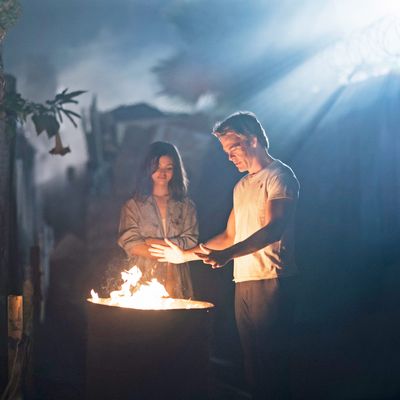
So this is how the story of Fauna Hodel ends. Her grandfather, who could also be her father, tries to kill her, but she summons the courage to defeat him and wound him in a way that would really hurt. Jay Singletary is inspired by Fauna’s story and the courage it brought to the surface of his character, and he seems to find a modicum of happiness, even if he remains haunted by the lives he’s taken. Ultimately, despite solid direction from the great Carl Franklin for the finale, I Am the Night ends by getting stuck in the corner it wrote itself into by blending history and fiction. Fauna Hodel’s true story of identity never quite felt at home in a noir mystery about the killer of the Black Dahlia, and placing both in the context of the Watts Riots in the finale only highlights how much this show was never quite the sum of its parts. Chris Pine was so good from premiere to finale that he practically made the show worth watching all on his own, and I Am the Night attracted some notable talent behind the camera, including Franklin and Patty Jenkins, but it’s ultimately a disappointment, a show that grabbed ideas from reality, mixed them with fiction, and ended up with an inconsistent mess.
Let’s start with the framing of the series finale, because it’s emblematic of where this show often went wrong. The writers choose to place the climax of Fauna Hodel’s search for the lost branches of her family tree against the backdrop of the 1965 Watts Riots, once again using real deaths (that of Elizabeth Short, a.k.a. the Black Dahlia, and the 34 people who died in the Watts Riots) to provide flavor to a fictional story. The symbolic purpose is clear: The pent-up frustration and pain that led to the Watts Riots is supposed to be mirrored in Fauna Hodel unleashing her inner turmoil on her grandfather, but it feels cheap and unearned. It’s not impossible to use real events as backdrops to fictional stories, but it’s a fine line between fiction that comments on history and fiction that exploits it.
As expected, most of the finale features the final meeting/showdown between George Hodel and his “granddaughter” (you have to love the emphasis and pause on that line delivery) Fauna Hodel. Fauna convinces Terence to take her to her mother Corinna’s to borrow money to get home after she hears that her mother has been stabbed. For reasons unexplained, Corinna drugs Fauna and hands her over to George for the final showdown.
Fauna wakes up in her slip, and finally gets to meet George face to creepy face. George calls Jay a “muckraker” and a “yellow journalist,” someone who he sued for libel and won. George Hodel is the worst kind of poser; the kind of guy who references Eugene O’Neill in conversation as if it means he’s impressive. One of the most interesting scenes of the year is the pre-credits sequence this week, in which a young George’s mother is told that her son is a mimic, someone without actual depth or talent of his own. He doesn’t know how to do or feel — he just knows how to talk.
And, oh, does he talk this episode. Monologuing more than Dr. Evil, he first goes on about Fauna growing up with simple people and feeling like she didn’t belong. When Billis comes to talk to him, George totally blows him off, talking about the riots instead of anything important, although Billis sees Fauna and he’s nervous that she could be the next Janice Brewster.
He goes back to Jay and tells him he needs solid gold — something more than Jay’s word. If Billis tries to go after George Hodel, he’ll just get killed, too. Jay has a crazy idea. He offers to confess to killing Janice Brewster himself, and will even put fingerprints on a knife they can say is the murder weapon. The deal is that they have to let Jay out and kill George. It would solve two problems, closing an open murder case and killing a monster. Jay looks lost when he says, “I was supposed to be a journalist.” Now maybe he can just be an avenger.
George stages a creepy dinner for his granddaughter, but she doesn’t have much of an appetite, so he gets right to business. He offers to paint her, leading her through a dungeon of surgical devices and other things from medical nightmares. In the back, near the drains for blood, there’s a painting studio, and he asks Fauna to pose. She goes to change behind a curtain and sees crime-scene photos hanging there. George monologues further about nature and instinct, and couldn’t be creepier if he tried. And he hits Fauna.
Jay escapes from the police transporting him, but it turns out that Fauna doesn’t need a rescuer. She gets a jump on George herself, knocking him to the ground and even turning a gun on him. She calls him on all his shit, telling him he’s kitsch and noting how her mother said she didn’t need to understand a song to sing it. George doesn’t understand anything. He just goes through the clichés. As she tells him, it’s boring to pretend that simple urges are high art. And that cuts George Hodel to the bone. Thank God she said it — although she probably should have shot him.
Jay gets there too late to find George, and he starts to freak out, smashing up the lab/studio/dungeon. Fauna calms him, and the two have a nice moment before they walk their separate ways, Fauna disappearing into the foggy night and Jay headed to the waters of Hawaii. In the series’s final beats, we see Fauna visit her mother in the hospital, and we end with a letter she sent Jay. He seems happy, and Fauna has found some semblance of the same, although it’s worth nothing that Jay still sees ghosts, and Fauna is walking through the rubble of the riots. These people may have closure, but they’re forever haunted.
Hush Hush
• Usually this is where I ask who is the season’s MVP, but it’s not even a close enough race to ask that question with a straight face. Chris Pine does a lot with very little here, avoiding the clichés that so much of the rest of the cast just tumbles into. Who would you give runner-up?
• If you’ve never seen Carl Franklin’s One False Move and Devil in a Blue Dress, go correct that oversight right now. They’re both phenomenal.
• If I Am the Night gets people more interested in the case of the Black Dahlia or even racial strife in Los Angeles in the mid-’60s, it’s done some good, I suppose. Go check out Brian De Palma’s The Black Dahlia for a VERY different take on some of the elements of this story.


